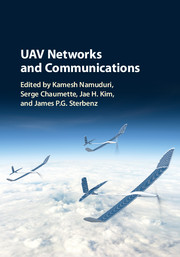Book contents
- Frontmatter
- Dedication
- Contents
- Preface
- Contributors
- 1 Introduction to UAV Systems
- 2 Air-to-Ground and Air-to-Air Data Link Communication
- 3 Aerial Wi-Fi Networks
- 4 Disruption-Tolerant Airborne Networks and Protocols
- 5 UAV Systems and Networks: Emulation and Field Demonstration
- 6 Integrating UAS into the NAS – Regulatory, Technical, and Research Challenges
- 7 Safety, Security, and Privacy Aspects in UAV Networks
- 8 Collaboration Between Autonomous Drones and Swarming
- 9 Real-World Applications
- References
- Index
1 - Introduction to UAV Systems
Published online by Cambridge University Press: 17 November 2017
- Frontmatter
- Dedication
- Contents
- Preface
- Contributors
- 1 Introduction to UAV Systems
- 2 Air-to-Ground and Air-to-Air Data Link Communication
- 3 Aerial Wi-Fi Networks
- 4 Disruption-Tolerant Airborne Networks and Protocols
- 5 UAV Systems and Networks: Emulation and Field Demonstration
- 6 Integrating UAS into the NAS – Regulatory, Technical, and Research Challenges
- 7 Safety, Security, and Privacy Aspects in UAV Networks
- 8 Collaboration Between Autonomous Drones and Swarming
- 9 Real-World Applications
- References
- Index
Summary
This chapter provides the background and context for unmanned aerial vehicles (UAVs) and UAV networks with a focus on their civilian applications. It discusses, for example, the types of UAVs, fuel, payload capacity, speed, and endurance. It will also discuss the state-of-the-art in engineering and technology aspects of UAVs and UAV networks and the advantages of UAV networks, including enhanced situational awareness and reduced latency in communications among the UAVs. It presents the applications of UAV networks, research opportunities, and challenges involved in designing, developing, and deploying UAV networks, and the roadmap for research in UAV networks.
Over recent decades, many different terms have been used to refer to UAVs, the most recent of which being remotely piloted aerial system (RPAS), which insists that the system is somehow always operated by somebody on the ground who is responsible for it. The term is very much like the old name for UAVs of the 1980s, that is remotely piloted vehicle (RPV). The RPAS puts emphasis on the fact that the aerial system includes not only the flying vehicle but also, for example, a ground control station, data link, and antenna. It also provides room for the case where several aircraft belonging to the same system may be remotely operated as a whole by a single human operator. In that case, it is not possible for the operator to actually control each flying vehicle as if he or she was an RC pilot.
Yet, in aeronautics, piloting an aircraft basically means flying an aircraft. It has a very precise meaning which is related to the capability to control the attitude of the vehicle with respect to its center of gravity. While most UAVs are remotely operated, they almost all have an on-board autopilot in charge of flying the aircraft. Therefore, it is not a remotely piloted vehicle but only a remotely operated vehicle where navigation commands are sent to the aircraft. Furthermore, navigation orders such as waypoints, routes, and decision algorithms may even be included in the on-board computer in order to complete the mission without human action along the way. In this way, human judgment is devoted to actions at higher levels, such as decision making or strategy definition. The term “remotely operated aircraft system” (ROAS) would therefore make more sense to the current scientific community.
- Type
- Chapter
- Information
- UAV Networks and Communications , pp. 1 - 25Publisher: Cambridge University PressPrint publication year: 2017
- 4
- Cited by



